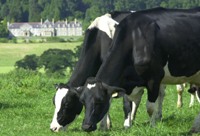Methane study

Cows on one of the University's farms
20 December 2010
Welsh institution leads battle against climate change.
New £3.9 million project to reduce damaging emissions from farm animals.
Aberystwyth University’s Institute of Biological, Environmental and Rural Sciences is heading a £3.9 million project to improve our understanding of the amounts of damaging methane that are emitted by agriculture and the value of the industry’s attempts to control it.
Working with teams from six other institutions across the UK, IBERS’ scientists will be assessing the amount of methane being released into the atmosphere by agricultural livestock and generating data that allow more accurate estimates of emissions throughout the UK.
"The fact that IBERS has been chosen to lead this work is recognition of the Institute’s international reputation," said IBERS Director, Professor Wayne Powell.
"Our world-class scientists have been working for many years on various projects to reduce methane emissions and, as well as working at the cutting edge of the new genomic technologies, we have more than 90 years’ experience of plant and animal breeding."
The work on methane is part of a broader £12.6 million research project called The Agricultural Greenhouse Gas Inventory Research Platform, which is funded by the Department of Environment, Agriculture and Rural Affairs in London, with contributions from the devolved administrations in Wales, Scotland and Northern Ireland.
Another project will work on nitrous oxide emissions and a third is studying data management and creating a new inventory structure for more accurate estimates of of greenhouse gas emissions.
Up to now, estimates have been based on general assumptions but IBERS’ work will help to develop a far more sophisticated system, assessing the effect of different types of livestock, different types of feedstuffs and different types of farming systems.
It will also assess how farmers are succeeding in cutting back on emissions by adapting their practices and will show which methods work best.
Over a period of 39 months, the project partners will be studying dairy cattle, beef cattle and sheep and, whilst the effects of manure will be considered, the main emphasis will be on the gases created in the animals’ gut.
"We will be using a combination of direct measurements from animals and modelling with existing data," said project leader, Dr. Jon Moorby
"The aim is to fill in key gaps in our knowledge to cover the areas of livestock agriculture that account for the most methane emissions."
Background facts
- Between 1990 and 2008, farming was responsible for about 38% of the UK’s methane emissions, mainly from the digestive systems of livestock and from their manure.
- Methane CH4 is 25 times more potent as a greenhouse gas than carbon dioxide.
- IBERS is leading the methane emissions project, costing £3.9 million over 39 months.
- The other institutions involved in the project are: Scottish Agricultural College, AFBI Hillsborough, the Universities of Reading and Nottingham, Rothamsted Research North Wyke and the National Physical Laboratory.
- Greenhouse gas emissions from agriculture have decreased over the last 20 years.
- Rothamsted Research is leading the nitrous oxide project.
- ADAS is leading the inventory structure project.
AU24010



